Assessing the Pandemic Aviation Crisis: Speculative Behavior, Government Bail Outs, and Accommodative Monetary Policy
Abstract
1. Introduction
2. Background and Literature Review
2.1. The Pandemic Context and the Research Problem
2.2. COVID-19: From Economic and Financial Crisis to Aviation Problem
2.3. COVID-19: Liquidity Crisis, Banking Crisis, and Monetary Policy
2.4. The Impact on Aviation of Social Containment, Public Health Policies and Economic Aid to Households
2.5. Airline Targeted Fiscal Policies
- (A)
- loans and loan guarantees;
- (B)
- equity acquisition;
- (C)
- hybrid financing;
- (D)
- wage subsidies.
2.6. Credit Default Swaps
2.7. Research Hypotheses Emerging from the Literature
3. Methodology and Data
3.1. Testing for Explosiveness
3.2. Sample
4. Results
5. Discussion
6. Conclusions
Author Contributions
Funding
Informed Consent Statement
Data Availability Statement
Acknowledgments
Conflicts of Interest
| 1. | Whether such QE frameworks played a role in awakening inflation remains to be concluded. For more on monetary policy regime shifts and inflation see, inter alia, Oliveira and Santos (2010) and Santos and Oliveira (2010). |
| 2. | Evidence from the September 11 attack and the ensuing aviation crisis suggested that LCCs recovered more quickly than FSCs (Gillen and Lall 2003). |
| 3. | In total, 24 slots were freed by Deutsche Lufthansa AG from 2020 to 2024 (Veríssimo 2024). |
References
- Air France–KLM. 2023. Air France-KLM Capital: Shareholding Structure. Available online: https://www.airfranceklm.com/en/finance/air-france-klm-capital/shareholding-structure (accessed on 3 April 2024).
- Air France–KLM. 2024. Air France-KLM Group: Consolidated Financial Statements 2023. Paris: Air France–KLM Group. [Google Scholar]
- Airways. 2024. Southwest Airlines’ Q4/Full-Year 2023 Financial Results. Available online: https://www.airwaysmag.com/legacy-posts/southwest-q4-fy-2023-financial-results (accessed on 7 May 2024).
- Andritzky, Jochen, and Manmohan Singh. 2006. The Pricing of Credit Default Swaps During Distress. IMF Working Papers 06: 254. [Google Scholar] [CrossRef]
- Apergis, Nicholas, Dan Danuletiu, and Bing Xu. 2022. CDS spreads and COVID-19 pandemic. Journal of International Financial Markets Institutions & Money 76: 101433. [Google Scholar] [CrossRef]
- Arrigo, Ugo, Massimo Beccarello, and Giacomo Di Foggia. 2023. Strategic Response of European Airlines to Market Dynamics: A Comparative Analysis. Administrative Sciences 13: 255. [Google Scholar] [CrossRef]
- Ashraf, Badar Nadeem. 2020. Economic impact of government interventions during the COVID-19 pandemic: International evidence from financial markets. Journal of Behavioral and Experimental Finance 27: 100371. [Google Scholar] [CrossRef]
- Baker, Scott R., Nicholas Bloom, Steven J. Davis, Kyle Kost, Marco Sammon, and Tasaneeya Viratyosin. 2020. The unprecedented stock market reaction to COVID-19. The Review of Asset Pricing Studies 10: 742–58. [Google Scholar] [CrossRef]
- Bannier, Christina E., Thomas Heidorn, and Heinz-Dieter Vogel. 2014. Characteristics and development of corporate and sovereign CDS. Journal of Risk Finance 15: 482–509. [Google Scholar] [CrossRef]
- Barua, Bipasha, and Suborna Barua. 2020. COVID-19 implications for banks: The case of an emerging economy with a weak financial system. SSRN Electronic Journal 3646961. [Google Scholar] [CrossRef]
- Baum, Christopher, Mustafa Caglayan, and Bing Xu. 2021. The impact of uncertainty on financial institutions: A cross-country study. International Journal of Finance and Economics 26: 3719–39. [Google Scholar] [CrossRef]
- Bernanke, Ben S., Jean Boivin, and Piotr Eliasz. 2005. Measuring monetary policy: A Factor Augmented Vector Autoregressive (FAVAR) approach. The Quarterly Journal of Economics 120: 387–422. [Google Scholar] [CrossRef]
- Bonaccolto, Giovanni, Nicola Borri, and Andrea Consiglio. 2023. Breakup and default risks in the great lockdown. Journal of Banking & Finance 147: 106308. [Google Scholar] [CrossRef]
- Bosio, Erica, Simeon Djankov, Filip Jolevski, and Rita Ramalho. 2020. Survival of Firms during Economic Crisis. World Bank Policy Research 9239. Available online: https://ssrn.com/abstract=3599546 (accessed on 7 May 2024).
- Brei, Michael, Blaise Gadanecz, and Aaron Mehrotra. 2020. SME lending and banking system stability: Some mechanisms at work. Emerging Markets Review 43: 100676. [Google Scholar] [CrossRef]
- Caglayan, Mustafa, and Bing Xu. 2019. Economic policy uncertainty effects on credit and stability of financial institutions. Bulletin of Economic Research 71: 342–47. [Google Scholar] [CrossRef]
- Capelle-Blancard, Gunther, and Adrien Desroziers. 2020. The stock market is not the economy? Insights from the COVID-19 crisis (June 16, 2020). CEPR Covid Economics 3638208. [Google Scholar] [CrossRef]
- CDC. 2023. CDC Museum COVID-19 Timeline. Available online: https://www.cdc.gov/museum/timeline/covid19.html (accessed on 20 April 2024).
- Cervera, Ignacio, and Isabel Figuerola-Ferretti. 2024. Credit risk and bubble behavior of credit default swaps in the corporate energy sector. International Review of Economics and Finance 89: 702–31. [Google Scholar] [CrossRef]
- Chang, Chun-Ping, Gen-Fu Feng, and Mingbo Zheng. 2021. Government fighting pandemic, stock market return and COVID-19 virus outbreak. Emerging Markets Finance and Trade 57: 2389–406. [Google Scholar] [CrossRef]
- Charalambakis, Evangelos, Federica Teppa, and Athanasios Tsiortas. 2024. Consumer participation in the credit market during the COVID-19 pandemic and beyond. Oxford Economic Papers, gpae019. [Google Scholar] [CrossRef]
- Chen, Ming-Hsiang, Ender Demir, Conrado Diego García-Goméz, and Adam Zaremba. 2020. The impact of policy responses to COVID-19 on U.S. travel and leisure companies. Annals of Tourism Research Empirical Insights 1: 100003. [Google Scholar] [CrossRef]
- Chiarella, Carl, Saskia ter Ellen, Xue-Zhong He, and Eliza Wu. 2015. Fear or fundamentals? Heterogeneous beliefs in the European sovereign CDS market. Journal of Empirical Finance 32: 19–34. [Google Scholar] [CrossRef]
- Choi, Sun-Yong. 2020. Industry volatility and economic uncertainty due to the COVID-19 pandemic: Evidence from wavelet coherence analysis. Finance Research Letters 37: 101783. [Google Scholar] [CrossRef]
- Clarke, Jamie. 2023. American Airlines Reports Q2 2022 Record Profit. Available online: https://aviationsourcenews.com/news/american-airlines-reports-q2-2022-record-profit/ (accessed on 10 December 2023).
- Companiesmarketcap. 2024. United Airlines Holdings—Total Debt. Available online: https://companiesmarketcap.com/united-airlines/total-debt/ (accessed on 11 May 2024).
- Coudert, Virginie, and Mathieu Gex. 2010. Contagion inside the Credit Default Swaps Market: The case of GM and Ford Crisis in 2005. International Financial Markets, Institutions and Money 20: 109–34. [Google Scholar] [CrossRef]
- Damette, Olivier, and Philippe Frouté. 2010. Is the crisis treatment exacerbating cautiousness or risk taking? Applied Financial Economics 20: 213–18. [Google Scholar] [CrossRef]
- Didier, Tatiana, Federico Huneeus, Mauricio Larrain, and Sergio L. Schmukler. 2021. Financing firms in hibernation during the COVID-19 pandemic. Journal of Financial Stability 53: 100837. [Google Scholar] [CrossRef]
- Diebold, Francis X., and Kamil Yilmaz. 2023. On the past, present, and future of the Diebold–Yilmaz approach to dynamic network connectedness. Journal of Econometrics 234: 115–20. [Google Scholar] [CrossRef]
- Ding, Wenzhi, Ross Levine, Chen Lin, and Wensi Xie. 2021. Corporate Immunity to the COVID-19 Pandemic. Journal of Financial Economics 141: 802–30. [Google Scholar] [CrossRef]
- ECB. 2023. Pandemic emergency purchase programme (PEPP). In ECB Monetary Policy Instruments. Frankfurt: European Central Bank (ECB)—Eurosystem. Available online: https://www.ecb.europa.eu/mopo/implement/pepp/html/index.en.html (accessed on 20 February 2024).
- European Commission. 2020. State Aid: Commission Approves French Plans to Provide €7 Billion in Urgent Liquidity Support to Air France. Available online: https://ec.europa.eu/commission/presscorner/detail/en/IP_20_796 (accessed on 30 September 2023).
- European Commission. 2022. The State Aid Temporary Framework. Available online: https://competition-policy.ec.europa.eu/state-aid/coronavirus/temporary-framework_en (accessed on 10 October 2023).
- European Commission. 2024. Coronavirus Outbreak—List of Member State Measures Approved under Articles 107(2)b, 107(3)b and 107(3)c TFEU and under the State Aid Temporary Framework. Available online: https://competition-policy.ec.europa.eu/state-aid/coronavirus_en (accessed on 12 March 2024).
- Fahlenbrach, Rüdiger, Kevin Rageth, and René M. Stulz. 2021. How valuable is financial flexibility when revenue stops? Evidence from the COVID-19 crisis. Review of Financial Studies 34: 5474–521. [Google Scholar] [CrossRef]
- Federal Reserve of St. Louis. 2023. Unemployment Rate. FRED—Economic Data St. Louis FED. Available online: https://fred.stlouisfed.org/series/UNRATE (accessed on 22 October 2023).
- Finbox. 2024. Financial Leverage for Delta Air Lines Inc. Available online: https://finbox.com/NYSE:DAL/explorer/financial_leverage/ (accessed on 4 June 2024).
- Fitch. 2021. Few Airlines Remain IG after Coronavirus-Driven Downgrades. Available online: https://www.fitchratings.com/research/corporate-finance/few-airlines-remain-ig-after-coronavirus-driven-downgrades-26-01-2021 (accessed on 20 December 2023).
- Forbes. 2023. The Global 2000. Available online: https://www.forbes.com/lists/global2000/?sh=484495e05ac0 (accessed on 12 November 2023).
- Gillen, David, and Ashish Lall. 2003. International transmission of shocks in the airline industry. Journal of Air Transport Management 9: 37–49. [Google Scholar] [CrossRef]
- Goldstein, Itay, Ralph S. Koijen, and Holger M. Mueller. 2021. COVID-19 and its impact on financial markets and the real economy. The Review of Financial Studies 34: 5135–48. [Google Scholar] [CrossRef]
- GuruFocus. 2024. American Airlines Group Inc. Reports Record Revenue and Significant Debt Reduction in 2023. Available online: https://www.gurufocus.com/news/2179785/american-airlines-group-inc-reports-record-revenue-and-significant-debt-reduction-in-2023?r=caf6fe0e0db70d936033da5461e60141 (accessed on 30 January 2024).
- ICAO. 2016. List of Government-Owned and Privatized Airlines. Montreal: International Civil Aviation Organization (ICAO). Available online: https://www.icao.int/sustainability/SiteAssets/Pages/Eap_ER_Databases/FINAL_Airlines%20Privatization.pdf (accessed on 14 March 2024).
- IMF. 2020. World Economic Outlook—The Great Lockdown. Washington, DC: International Monetary Fund. [Google Scholar]
- ISDA. 2014. Credit Derivatives Definitions and Standard Reference Obligations—FAQ. New York City: International Swaps and Derivatives Association. [Google Scholar]
- Jaroenjitrkam, Anutchanat, Suntichai Kotcharin, and Sakkakon Maneenop. 2023. Corporate resilience to the COVID-19 pandemic: Evidence from the airline industry. The Asian Journal of Shipping and Logistics 39: 26–36. [Google Scholar] [CrossRef]
- Jinjarak, Yothin, Rashad Ahmed, Sameer Nair-Desai, Weining Xin, and Joshua Aizenman. 2020. Pandemic shocks and fiscal-monetary policies in the Eurozone: COVID-19 dominance during January–June 2020. National Bureau of Economic Research 4: 1557–80. [Google Scholar]
- Jordà, Òscar, Sanjay R. Singh, and Alan M. Taylor. 2020. Longer-Run Economic Consequences of Pandemics. In Federal Reserve Bank of San Francisco. Working Paper 2020-09. San Francisco: Federal Reserve Bank of San Francisco. [Google Scholar] [CrossRef]
- Kaczmarek, Tomasz, Katarzyna Perez, Ender Demir, and Adam Zaremba. 2021. How to survive a pandemic: The corporate resiliency of travel and leisure companies to the COVID-19 outbreak. Tourism Management 84: 104281. [Google Scholar] [CrossRef]
- Karp, Aaron. 2020. Delta Has Received $2.7 billion in US Federal Aid. Aviation Week Network, April 22. Available online: https://aviationweek.com/air-transport/airports-networks/delta-has-received-27-billion-us-federal-aid (accessed on 20 May 2024).
- Kotcharin, Suntichai, Sakkakon Maneenop, and Anutchanat Jaroenjitrkam. 2023. The impact of government policy responses on airline stock return during the COVID-19 crisis. Research in Transportation Economics 99: 101298. [Google Scholar] [CrossRef]
- Kumari, Vineeta, Brajes Kumar Tiwari, Piyush Gupta, and Dharen Kumar Pandey. 2022. How the global airline industry behaved to restrictions on air travel to India? An event study analysis. Economic Research-Ekonomska Istraživanja 36: 1040–54. [Google Scholar] [CrossRef]
- Kumari, Vineeta, Rahul Kumar, and Dharen Kumar Pandey. 2023. Restrictions on air travel to India and the global airline industry—An event study and cross-sectional approach. Asia Pacific Management Review 28: 240–51. [Google Scholar] [CrossRef]
- Lee, Jae Woon. 2021. Government Bailouts of Airlines in the COVID-19 Crisis: Improving Transparency in International Air Transport. Journal of International Economic Law 24: 703–23. [Google Scholar] [CrossRef]
- Liao, Maozhu, Chuntao Wu, and Hongmeng Yan. 2022. Recovery of Chinese low-cost carriers after the outbreak of COVID-19 pandemic. Journal of Air Transport Management 105: 102282. [Google Scholar] [CrossRef]
- Liu, Shasha, and Toshiyuki Yamamoto. 2022. Role of stay-at-home requests and travel restrictions in preventing the spread of COVID-19 in Japan. Transportation Research Part A: Policy and Practice 159: 1–16. [Google Scholar] [CrossRef]
- Liu, Ya, Buhui Qiu, and Teng Wang. 2021. Debt rollover risk, credit default swap spread and stock returns: Evidence from the COVID-19 crisis. Journal of Financial Stability 53: 100855. [Google Scholar] [CrossRef]
- Ludvigson, Sydney C., Sai Ma, and Serena Ng. 2020. COVID-19 and the macroeconomic effects of costly disasters. National Bureau of Economic Research, w26987. [Google Scholar] [CrossRef]
- Lufthansa. 2024. Lufthansa Group—Annual Report 2023. Frankfurt: Deutsche Lufthansa AG. [Google Scholar]
- Lusa. 2024. Bruxelas aprova ajudas estatais à Air France-KLM após tribunal as anular. Available online: https://eco.sapo.pt/?p=1461748 (accessed on 10 July 2024).
- Maneenop, Sakkakon, and Suntichai Kotcharin. 2020. The impacts of COVID-19 on the global airline industry: An event study approach. Journal of Air Transport Management 89: 101920. [Google Scholar] [CrossRef]
- Meng, Fanyu, Wenwu Gong, Jun Liang, Xian Li, Yiping Zeng, and Lili Yang. 2021. Impact of different control policies for COVID-19 outbreak on the air transportation industry: A comparison between China, the US and Singapore. PLoS ONE 16: e0248361. [Google Scholar] [CrossRef]
- Milstein, Eric, and David Wessel. 2021. What Did the Fed do in Response to the COVID-19 Crisis? Washington, DC: Brookings Institution. Available online: https://policycommons.net/artifacts/4142729/what-did-the-fed-do-in-response-to-the-covid-19-crisis/4951201/ (accessed on 15 February 2024).
- Narayan, Paresh Kumar, Dinh Hoang Bach Phan, and Guangqiang Liu. 2021. COVID-19 lockdowns, stimulus packages, travel bans, and stock returns. Finance Research Letters 38: 101732. [Google Scholar] [CrossRef] [PubMed]
- Oliveira, Maria Alberta, and Carlos Santos. 2010. Looking for a Change Point in French Monetary Policy in the Early Eighties. Applied Economics Letters 17: 387–92. [Google Scholar] [CrossRef]
- Oliveira, Maria Alberta, and Carlos Santos. 2015. Market exuberance in sovereign credit default swaps: Assessing the EU regulatory framework and trading profit opportunities. Investment Management and Financial Innovations 12: 70–80. Available online: https://www.businessperspectives.org/index.php/journals/investment-management-and-financial-innovations/issue-101/market-exuberance-in-sovereign-credit-default-swaps-assessing-the-eu-regulatory-framework-and-trading-profit-opportunities (accessed on 12 September 2024).
- Oliveira, Maria Alberta, and Carlos Santos. 2018. Determinants of credit default swaps implied ratings during the crisis: Was sovereign risk mispriced? Investment Management and Financial Innovations 15: 1–14. [Google Scholar] [CrossRef]
- Oliveira, Maria Alberta, and Carlos Santos. 2022. Unveiling trading patterns: iTraxx Europe financials from the great financial crisis to ECB monetary easing. Banks and Bank Systems 17: 188–200. [Google Scholar] [CrossRef]
- Padungsaksawasdi, Chaiyuth, and Sirimon Treepongkaruna. 2021. Chasing for information during the COVID-19 panic: The role of Google search on global stock market. Cogent Economics & Finance 9: 1930669. [Google Scholar] [CrossRef]
- Padungsaksawasdi, Chaiyuth, and Sirimon Treepongkaruna. 2023. Investor attention and global stock market volatility: Evidence from COVID-19. Journal of Emerging Market Finance 22: 85–104. [Google Scholar] [CrossRef]
- Pagano, Marco, Christian Wagner, and Joseph Zechner. 2023. Disaster resilience and asset prices. Journal of Financial Economics 150: 103712. [Google Scholar] [CrossRef]
- Palladini, Giorgia, and Richard Portes. 2011. Sovereign CDS and Bond Pricing Dynamics in the Euro Area. NBER Working Paper 17586. Cambridge: National Bureau of Economic Research. [Google Scholar] [CrossRef]
- Phillips, Peter C. B., Shuping Shi, and Jun Yu. 2015a. Testing for Multiple Bubbles: Historical Episodes of Exuberance and Collapse in the S&P 500. International Economic Review 56: 1043–78. [Google Scholar] [CrossRef]
- Phillips, Peter C. B., Shuping Shi, and Jun Yu. 2015b. Testing for Multiple Bubbles: Limit Theory of Real-time Detectors. International Economic Review 56: 1079–134. [Google Scholar] [CrossRef]
- Phillips, Peter C. B., Yangru Wu, and Jun Yu. 2011. Explosive behavior in the 1990s Nasdaq: When did exuberance escalate asset values? International Economic Review 52: 201–26. [Google Scholar] [CrossRef]
- Sakawa, Hideaki, and Naoki Watanabel. 2023. The impact of the COVID-19 outbreak on Japanese shipping industry: An event study approach. Transport Policy 130: 130–40. [Google Scholar] [CrossRef] [PubMed]
- Santos, Carlos, and Maria Alberta Oliveira. 2010. Assessing French Inflation Persistence with Impulse Saturation Break Tests and Automatic General-To-Specific Modeling. Applied Economics 42: 1577–89. [Google Scholar] [CrossRef]
- Sun, Xiaoqian, Sebastian Wandelt, and Anming Zhang. 2021. Delayed reaction towards emerging COVID-19 variants of concern: Does history repeat itself? Transportation Research Part A: Policy and Practice 152: 203–15. [Google Scholar] [CrossRef]
- Sun, Xiaoqian, Sebastian Wandelt, and Anming Zhang. 2023. A data-driven analysis of the aviation recovery from the COVID-19 pandemic. Journal of Air Transport Management 109: 102401. [Google Scholar] [CrossRef] [PubMed]
- US Treasury 2023. Loans to Air Carriers, Eligible Businesses, and National Security Businesses. Available online: https://home.treasury.gov/policy-issues/coronavirus/assistance-for-industry/loans-to-air-carriers-eligible-businesses-and-national-security-businesses (accessed on 25 April 2024).
- Veríssimo, André. 2024. Bruxelas abre investigação a ajudas de Estado concedidas à Lufthansa na pandemia. Available online: https://eco.sapo.pt/?p=1460126 (accessed on 12 July 2024).
- Wallace, Alicia. 2022. Southwest Got Billions of Dollars in Taxpayer Aid. Why Is Its Service Still a Mess? CNN Business. December 28. Available online: https://edition.cnn.com/2022/12/28/business/southwest-pandemic-aid-meltdown/index.html (accessed on 19 October 2023).
- Zaremba, Adam, David Y. Aharon, Ender Demir, Renatas Kizys, and Dariusz Zawadka. 2021. COVID-19, government policy responses, and stock market liquidity around the world: A note. Research in International Business and Finance 56: 101359. [Google Scholar] [CrossRef]
- Zhai, Pengxiang, Fei Wu, Qiang Ji, and Duc Khuong Nguyen. 2022. From fears to recession? Time-frequency risk contagion among stock and credit default swap markets during the COVID pandemic. International Journal of Finance & Economics 29: 551–80. [Google Scholar] [CrossRef]

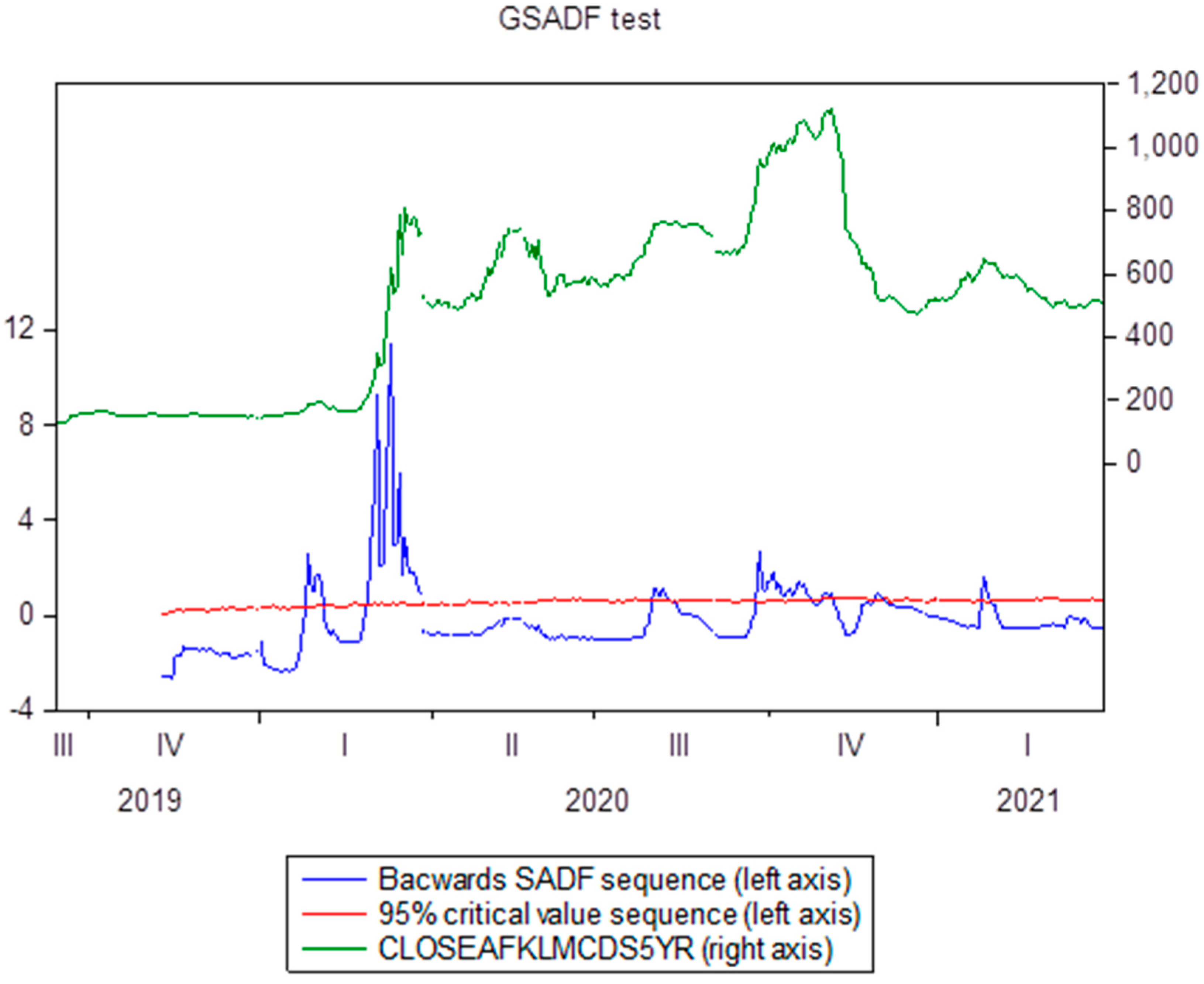
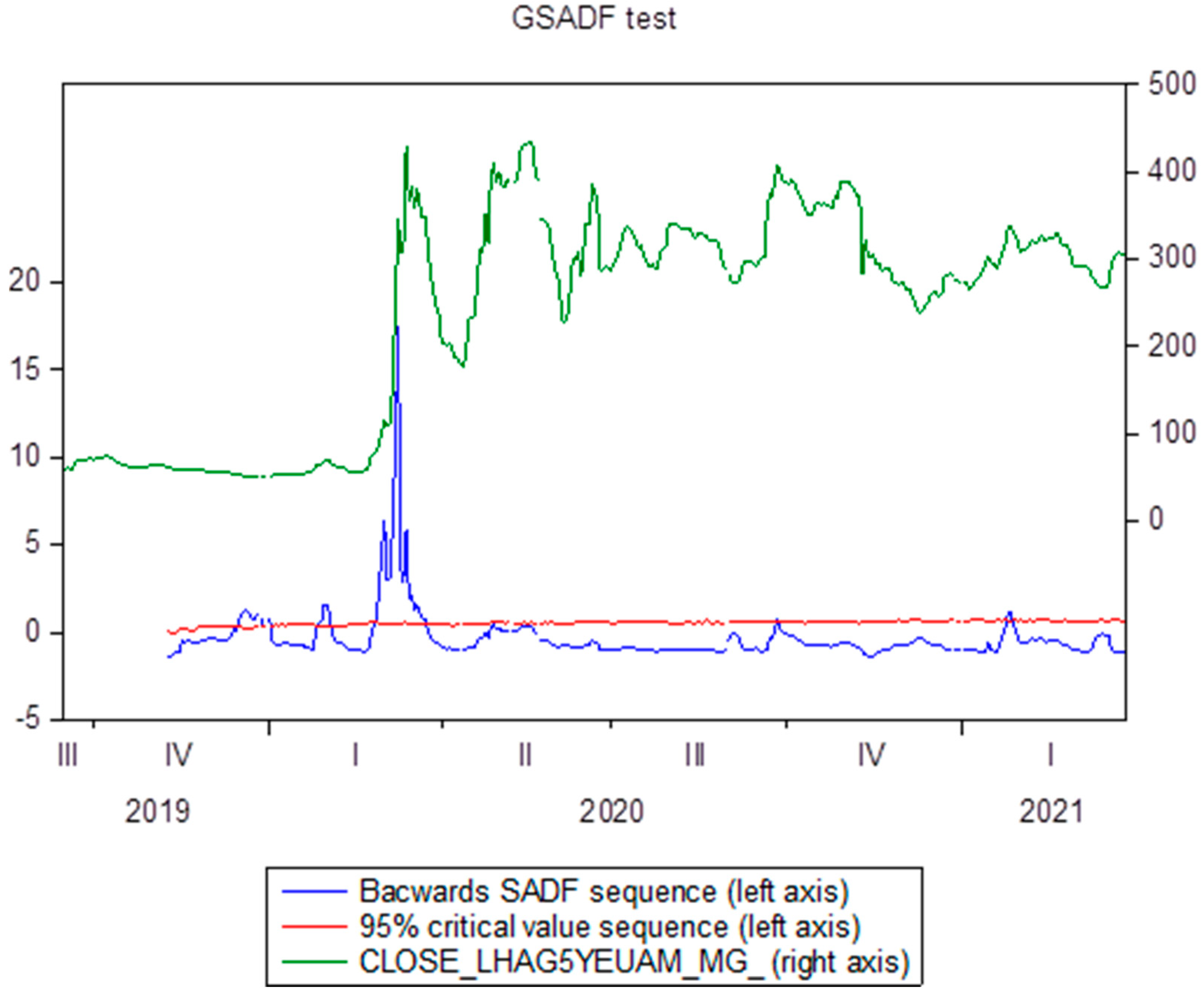

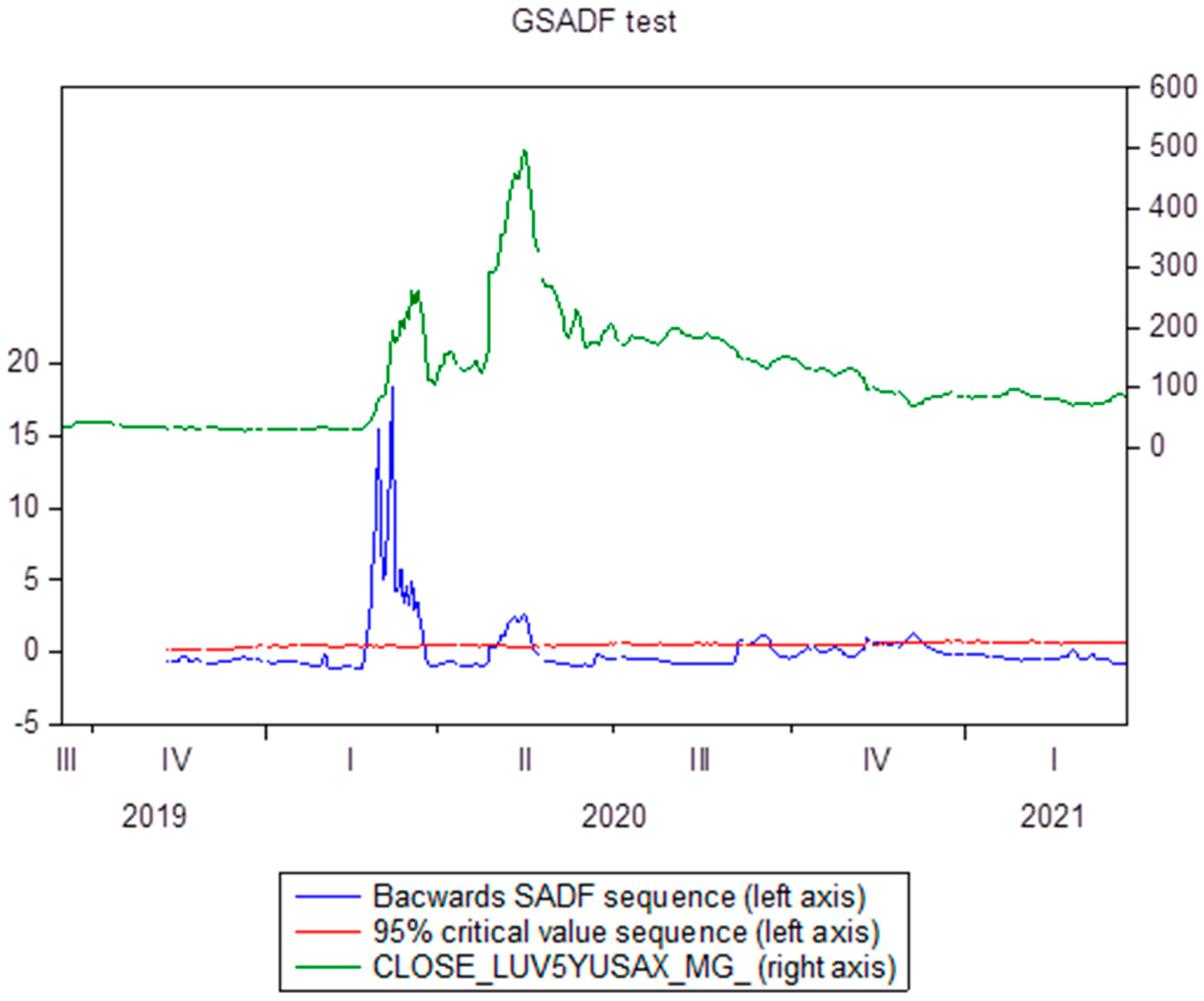
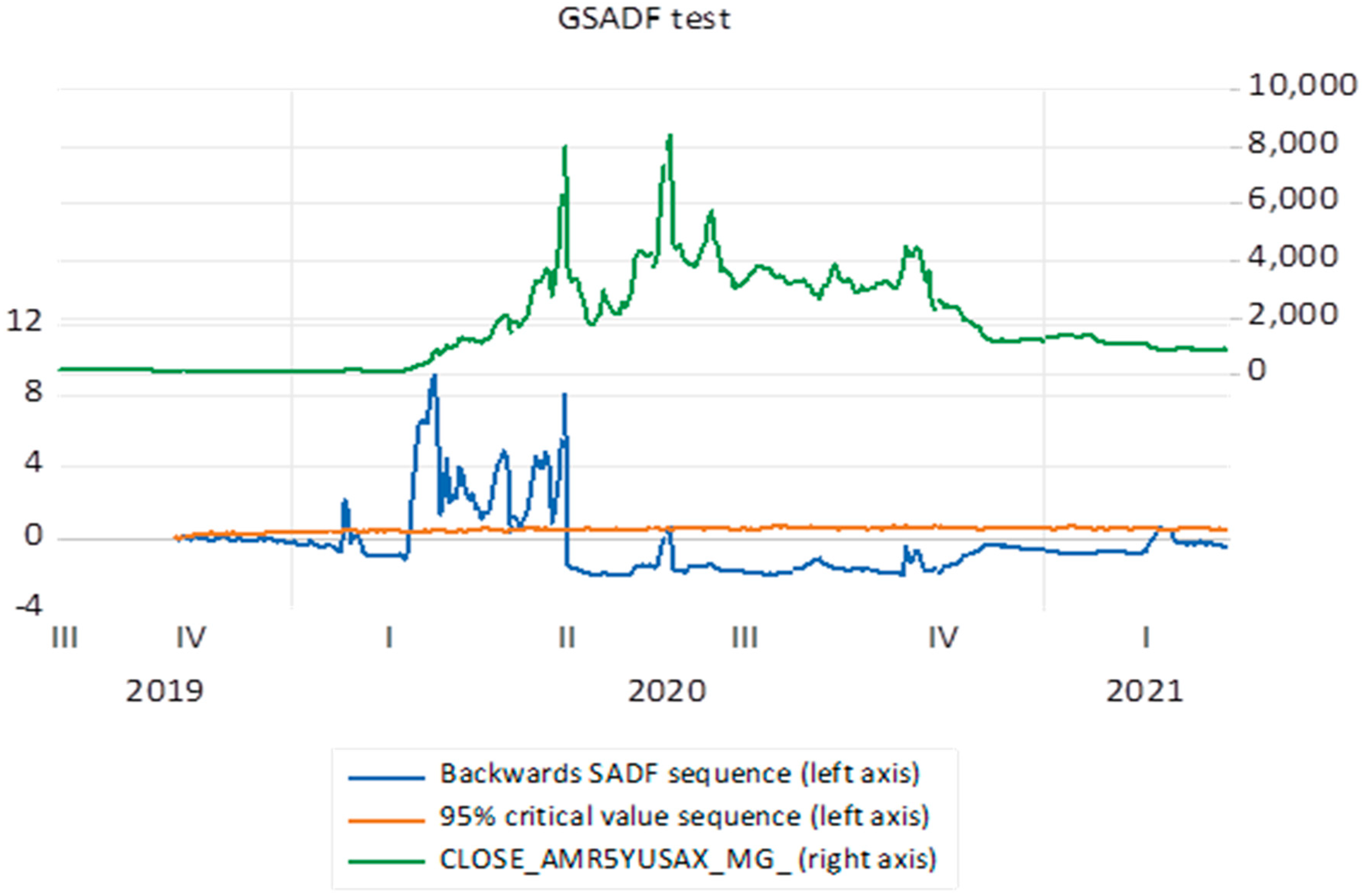
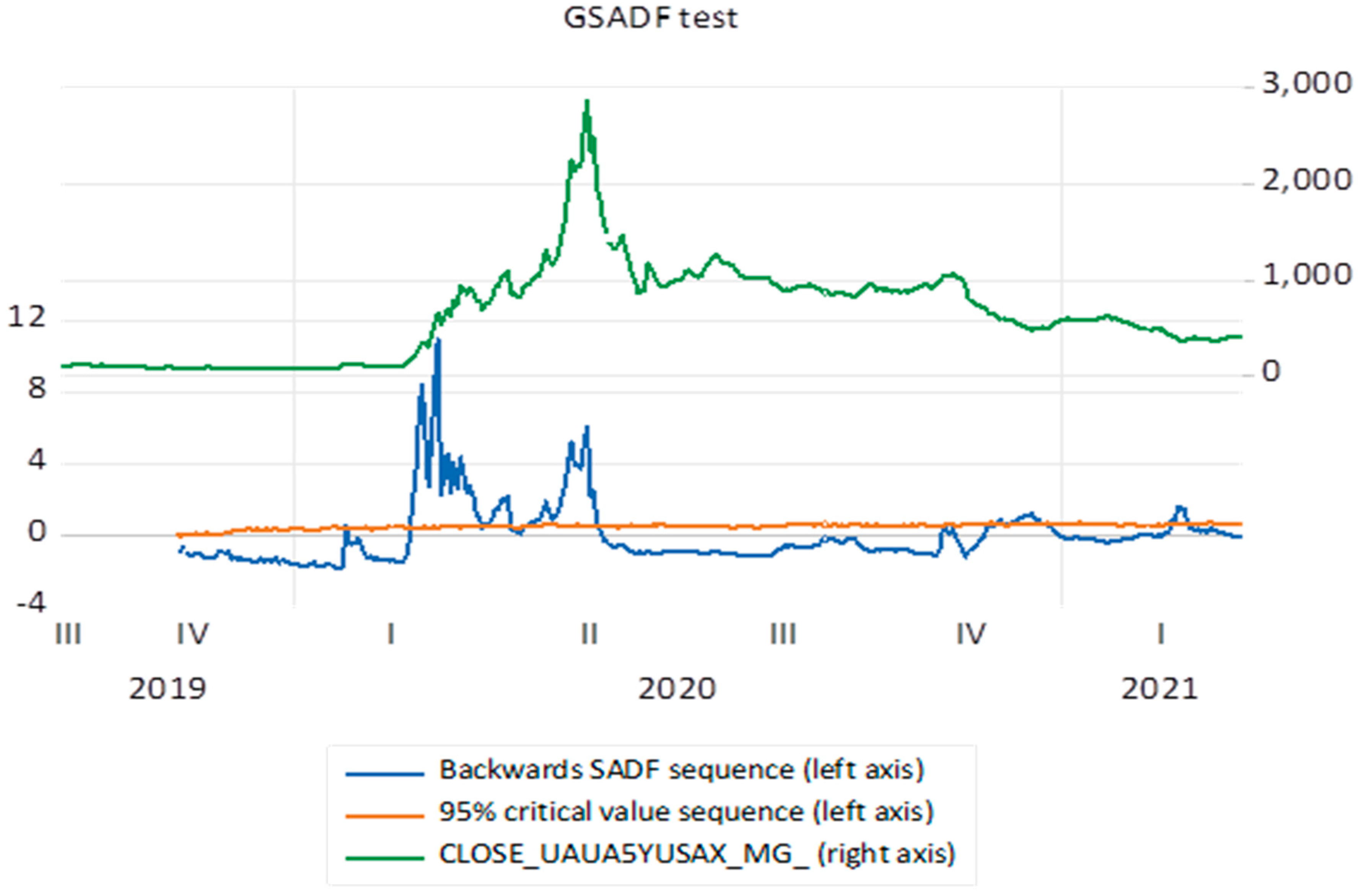
| Delta Airlines | Southwest Airlines | American Airlines | United Airlines | Air France–KLM | Deutsche Lufthansa AG | |
|---|---|---|---|---|---|---|
| Average | 415.851 | 118.596 | 1750.349 | 640.007 | 503.875 | 235.756 |
| Std. Error | 14.877 | 4.519 | 83.173 | 25.516 | 13.687 | 6.266 |
| Median | 356.337 | 91.129 | 1238.047 | 592.938 | 528.494 | 287.179 |
| Variance | 83,997.278 | 7800.519 | 2,538,821.95 | 242,189.597 | 70,810.352 | 15,274.323 |
| Kurtosis | −0.832 | 3.503 | 1.133 | 2.106 | −0.687 | −1.336 |
| Asymmetry | 0.335 | 1.616 | 1.044 | 1.035 | 0.137 | −0.472 |
| Interval | 1149.192 | 467.122 | 8269.046 | 2806.388 | 991.049 | 384.509 |
| Minimum | 61.91 | 29.253 | 133.648 | 71.5 | 133.028 | 49.409 |
| Maximum | 1211.102 | 496.375 | 8402.694 | 2877.888 | 1124.077 | 433.918 |
| Air France–KLM | Deutsche Lufthansa AG | |||
|---|---|---|---|---|
| Observed | Critical 1% | Observed | Critical 1% | |
| GSADF statistic | 11.48416 *** | 2.924427 | 17.46319 *** | 2.910167 |
| Delta Airlines | Southwest Airlines | |||
|---|---|---|---|---|
| Observed | Critical 1% | Observed | Critical 1% | |
| GSADF statistic | 14.45049 *** | 2.909588 | 18.42378 *** | 2.924947 |
| American Airlines | United Airlines | |||
|---|---|---|---|---|
| Observed | Critical 1% | Observed | Critical 1% | |
| GSADF statistic | 9.160579 *** | 2.930174 | 10.94848 *** | 2.930873 |
| Airlines | CDS Spread Mid-May 2024 | Pre-Pandemic Stock Price | Stock Price Mid-May 2024 | Additional Information and Analysis |
|---|---|---|---|---|
| Delta Airlines | 136.85 | USD 58.9 per share | USD 50 per share | Leverage decreased 60.3% in 2021, 41.1% in 2022, and 39.6% in 2023 (Finbox 2024). |
| Stock prices have not recovered to pre-pandemic levels: trading below USD 38 per share for most of the post-pandemic period. | ||||
| Southwest Airlines | 100 | USD 58 per share | USD 28 per share | Liquidity of USD 12.5 billion for 2023, more than its outstanding debt of USD 8 billion (low bankruptcy risk); debt reduced by 71.63% in 2023 (Airways 2024). |
| Spread CDS extremely close to September 2019, indicating that credit risk was not a concern. | ||||
| American Airlines | 1036 | USD 29.28 per share | USD 14 per share | Reduction of total debt in 2023 (USD 3.2 billion) closer to the target for debt reduction before 2025. Already achieved 75% of that target (GuruFocus 2024). |
| CDS spreads and stock prices have not recovered to pre-pandemic levels. Since the end of the pandemic period, stock has never been quoted above USD 17. | ||||
| United Airlines | 365.56 | USD 80 per share | USD 52 per share | Reduced total debt by 19.41% in 2023; pre-pandemic leverage problem, with debt increasing since 2018 (Companiesmarketcap 2024). |
| In the post-pandemic period, shares have never been quoted above USD 57. | ||||
| Air France-KLM | 196.61 | EUR 48.23 per share | EUR 10.56 per share | Non-current financial liabilities lowered from EUR 9.657 million in 2022 to EUR 7.538 million in 2023. Net cost of financial debt dropped from EUR 528 to 347 million (Air France–KLM 2024). |
| CDS market has a positive assessment of the credit risk, with spreads well below pandemic levels. Stock prices are resistant to recovery and following a downward trend, never rising above EUR 22 in the post-pandemic period. | ||||
| Deutsche Lufthansa AG | 115.74 | EUR 10.86 per share | EUR 6.7 per share | Reduction in borrowing from EUR 12.708 million in 2022 to EUR 11.376 million in 2023 (Lufthansa 2024). |
| Spreads had dropped, suggesting a reduction in default risk. Stock prices have never recovered to pre-pandemic levels. |
Disclaimer/Publisher’s Note: The statements, opinions and data contained in all publications are solely those of the individual author(s) and contributor(s) and not of MDPI and/or the editor(s). MDPI and/or the editor(s) disclaim responsibility for any injury to people or property resulting from any ideas, methods, instructions or products referred to in the content. |
© 2024 by the authors. Licensee MDPI, Basel, Switzerland. This article is an open access article distributed under the terms and conditions of the Creative Commons Attribution (CC BY) license (https://creativecommons.org/licenses/by/4.0/).
Share and Cite
Costa, V.; Oliveira, M.A.; Santos, C. Assessing the Pandemic Aviation Crisis: Speculative Behavior, Government Bail Outs, and Accommodative Monetary Policy. Economies 2024, 12, 258. https://doi.org/10.3390/economies12100258
Costa V, Oliveira MA, Santos C. Assessing the Pandemic Aviation Crisis: Speculative Behavior, Government Bail Outs, and Accommodative Monetary Policy. Economies. 2024; 12(10):258. https://doi.org/10.3390/economies12100258
Chicago/Turabian StyleCosta, Viviana, Maria Alberta Oliveira, and Carlos Santos. 2024. "Assessing the Pandemic Aviation Crisis: Speculative Behavior, Government Bail Outs, and Accommodative Monetary Policy" Economies 12, no. 10: 258. https://doi.org/10.3390/economies12100258
APA StyleCosta, V., Oliveira, M. A., & Santos, C. (2024). Assessing the Pandemic Aviation Crisis: Speculative Behavior, Government Bail Outs, and Accommodative Monetary Policy. Economies, 12(10), 258. https://doi.org/10.3390/economies12100258







